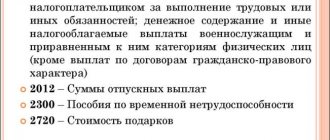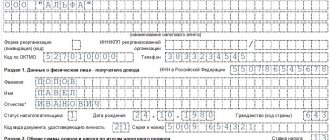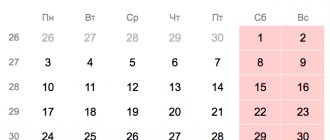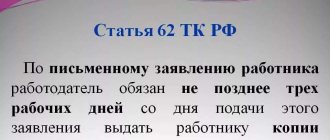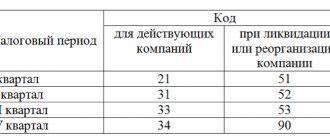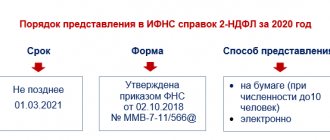Innovations in the RSV-1 form since 2015
Changes in the reporting of entrepreneurs to extra-budgetary funds affected the procedure for submitting it. According to Federal Law No. 406-FZ of December 1, 2014, different deadlines are established for sending documents in paper and electronic form.
To prepare a standard report on paper, 1 month and 15 days are still allotted from the end of the first quarter, half a year, 9 months and at the end of the year. The electronic document can be sent 5 days later. If the deadline falls on a weekend, it is moved to the first working day.
Thus, RSV-1 in the new form in 2015 must be submitted in printed form:
- before February 16 for the previous year;
- until May 15 for the 1st quarter;
- until August 17 for the first half of the year;
- until November 16, 9 months in advance.
Electronic reporting must be sent via telecommunication channels before February 24 (for 2014), in the current reporting year - before May 20, August 20 and November 20.
The obligation to report via the Internet is imposed on employers with more than 25 employees (previously this restriction applied to organizations with a staff of 50 or more people). If the enterprise employs 25 people or less, it is allowed to submit documents to the Pension Fund on paper.
The procedure for submitting reports to the Pension Fund in 2015
Policyholders provide to the Pension Fund reporting on insurance premiums for compulsory pension and compulsory medical insurance, as well as individual personalized accounting information for each insured employee using a single reporting form approved by the Resolution of the Pension Fund of the Russian Federation, registered with the Ministry of Justice of the Russian Federation on February 18, 2014 and published in Rossiyskaya Gazeta » No. 41 dated 02/21/2014.
A unified reporting form allows you to reduce the volume of reporting information and eliminate inconsistencies between the data provided by policyholders on insurance premiums and personalized accounting.
Features of the unified reporting form:
— payment of insurance premiums for periods starting from 2014 is reflected in a single payment document without separating the insurance and savings part;
- reflects the debt on insurance premiums, additional accrual and payment of insurance premiums for the periods 2010 - 2013;
— the new subsection 2.4 of the form reflects the specifics of payment of insurance premiums at additional tariffs based on the results of a special assessment of working conditions from January 1, 2014 and certification of workplaces before January 1, 2014;
— individual information does not indicate the amount of insurance premiums paid.
Unified reporting from January 1, 2015 must be submitted to the territorial bodies of the Pension Fund quarterly no later than the 15th day of the second calendar month in paper form, and in the form of an electronic document no later than the 20th day of the second calendar month following the reporting period (quarter, half-year, nine months and calendar year).
If the last day of the period falls on a weekend or non-working holiday, then the end of the period is considered to be the next working day following it.
This provision provides for an extension of the deadline for submitting reports for payers submitting reports electronically.
Thus, the last dates for submitting reports in paper form in 2015 are February 16, May 15, August 17, November 16, and when submitting reports electronically - February 20, May 20, August 20, November 20.
If the number of employees exceeds 25 people, reporting must be submitted electronically with an electronic digital signature.
Programs for preparing and checking reports, which greatly facilitate the process of preparing and submitting reports for insurance premium payers, are freely available on the PFR website in the “Electronic Services” section.
The Pension Fund recommends that residents use the Pension Fund’s electronic service “Cabinet of the Insurance Contribution Payer.” All document forms, data formats, and reporting verification rules are posted here. In the Account you can view the register of payments, receive a certificate on the status of settlements, issue a payment order, calculate insurance premiums, issue receipts, check statements and much more in real time.
Contents of the RSV-1 form
The new PFR form RSV-1 includes the following sections:
- title page;
- No. 1 – data on accrued and paid insurance premiums (to be completed by all companies);
- No. 2 – calculations according to the main and additional tariffs (for all companies);
- No. 3 – calculations for organizations enjoying the right to preferential tariffs;
- No. 4 - the amount of additional charges for insurance premiums;
- No. 5 – payments to members of student teams performing work and providing services on the basis of an employment contract or civil contract;
- individual information on length of service and insurance payments for each employee.
Filling out the RSV-1 form
The procedure for filling out the new RSV-1 form is regulated by Appendix 2 to Resolution No. 2p. According to this document, the following are required for registration by all organizations registered as payers in the Pension Fund of Russia: the title page and the first 2 sections of the form. If a company applied several tariffs during the reporting period, a separate sheet is filled out for each of them.
Title page design
On the title page, the organization indicates the following information:
- name of the legal entity or individual entrepreneur;
- registration number of the company in the Pension Fund of Russia;
- INN/KPP, activity code according to OKVED;
- year and reporting period (3, 6, 9 or 0);
- average number of employees and number of insured persons;
- correction number (code 000 for the primary document, 001 and further for clarifying ones);
- type of adjustment (1 – change in indicators affecting the calculation of pension contributions; 2 – adjustment of amounts accrued to the Pension Fund; 3 – clarification on the calculation of payments to the compulsory medical insurance fund);
- number of pages and attachments to the form;
- details of the payer's representative, details of the authorizing document, signature certifying the correctness of the information provided.
Completing section No. 1
The tabular form “Calculation of accrued and paid insurance premiums” includes amounts calculated and transferred in favor of extra-budgetary funds for pension and health insurance of employees. Pension contributions paid in the period from 2010 to 2013, when filling out the report, must be divided into savings and insurance parts and indicated in separate columns - 4 and 5. Starting from 2014, accrued payments are entered as a single amount in column 3. Columns 6, 7 are intended for contributions at additional tariffs, 8 – for transfers to the Compulsory Medical Insurance Fund.
The amounts of debts (positive value), overpayments (with a “-” sign), and additional accruals at the beginning and end of the reporting period are distributed among the lines.
RSV-1: section 2
Section 2 reveals the indicators on the basis of which insurance premiums are calculated:
- Subsection 2.1 – amounts of cash payments to personnel minus expenses not subject to insurance. This forms the basis for calculating pension contributions. Calculations for health insurance are similar.
- Subsections 2.2 – 2.4 are necessary for calculating contributions for additional tariffs that are applied by enterprises with harmful and dangerous working conditions.
The obligation to make contributions according to additional tariffs arises for organizations that, based on the results of certification of workplaces carried out before January 1, 2014, but no more than 5 years ago, classified the operating conditions of all or certain groups of employees as 3 and 4 classes. Since 2014, the degree of harmfulness of work is determined as a result of a special assessment of working conditions.
Personnel recognized as hazardous (class 3) and dangerous (class 4) workers have the right to early retirement. The types of work that can be classified under this classification are listed in Law No. 173-FZ of December 17, 2001 (Article 1, paragraphs 1-18). When filling out the PFR form RSV-1, subsections 2.2 and 2.3 provide calculations of the insurance base and contributions for additional tariffs, and 2.4 contains their breakdown by subclass of labor: dangerous (code 1) and harmful (code 2).
How to take into account changes in certain types of payments when filling out the RSV-1 Pension Fund for the first quarter of 2015
Since 2015, not only the list of taxable and non-taxable payments has changed, but also the procedure for calculating insurance premiums. This should be kept in mind when forming the taxable base indicator.
Severance pay upon dismissal
Since 2015, severance pay upon dismissal in an amount not exceeding three times the average monthly salary is not subject to insurance contributions (subclause “e”, paragraph 2, part 1, article 9 of Law No. 212-FZ).
Also, severance pay upon dismissal is not subject to contributions in an amount not exceeding six times the average monthly salary:
- employees of companies located in the Far North and equivalent areas;
- managers, deputy managers and chief accountants.
For the purposes of calculating insurance contributions to the Pension Fund for an amount exceeding the established limit, the reason for dismissal does not matter.
Payments to temporarily staying foreigners
Contributions to compulsory pension insurance . Since 2015, companies have been charging insurance premiums to compulsory insurance for payments to temporarily staying in the Russian Federation who have concluded:
- employment contract;
- civil contract, the subject of which is the performance of work and provision of services;
- other types of civil contracts listed in paragraph 1 of Article 7 of Federal Law No. 167-FZ of December 15, 2001 (hereinafter referred to as Law No. 167-FZ).
Temporarily staying foreign citizens are insured persons from the date of conclusion of such contracts. The period for which the contract was concluded has no significance since 2015 (Clause 1, Article 7 of Law No. 167-FZ).
Contributions for payments to employees who are temporarily staying foreigners are calculated at the rate established for citizens of the Russian Federation to finance an insurance pension, regardless of the year of birth of the foreigner (Clause 2, Article 22.1 of Law No. 167-FZ).
In 2015, from payments to 711,000 rubles. contributions must be calculated at a rate of 22%, and for payments over 711,000 rubles. - at a tariff of 10% (clause 2 of article 33.1 of Law No. 167-FZ).
Contributions for compulsory health insurance . Payments in favor of temporarily staying foreigners are not subject to compulsory medical insurance contributions, since they are not insured persons (Article 10 of the Federal Law of November 29, 2010 No. 326-FZ, clause 15 of Part 1 of Article 9 of Law No. 212-FZ).
An exception to these rules are foreign workers temporarily staying in the territory of the Russian Federation, who are (Table 3 below):
- citizens of the republics of Belarus, Kazakhstan and Armenia (clause 3 of article 98 of the Treaty on the Eurasian Economic Union of May 29, 2014);
- refugees who have the right to medical care in accordance with subparagraph 7 of paragraph 1 of Article 6 and subparagraph 7 of paragraph 1 of Article 8 of the Federal Law of February 19, 1993 No. 4528-1 “On Refugees”.
Table 3 General rates of contributions charged for payments to employees - temporarily staying foreigners, since 2015
| Employee categories | Tariff of contributions to the Pension Fund from payments | Tariff of contributions to the FFOMS | |
| Up to 711,000 rub. | Over 711,000 rub. | ||
| Temporarily staying foreigners | 22% | 10% | — |
| Temporarily staying citizens of the republics of Belarus, Kazakhstan or Armenia | 22% | 10% | 5,1% |
| Foreigners are highly qualified specialists | — | — | — |
| Temporary refugees | 22% | 10% | 5,1% |
Payments to disabled employees
Since 2015, insurance premiums for payments to disabled employees must be calculated according to the tariffs applied by the company.
For example, for IT companies, reduced rates of insurance contributions to the Pension Fund are 8%, and to the Federal Compulsory Medical Insurance Fund - 4%. At the same rates, it must charge contributions for payments to disabled employees.
If a company employs disabled people, it should not have insured person codes in its reporting for the first quarter of 2015: OOI, VZHOI and VPPOI.
Payment for four days of care for disabled children
Since 2015, the ambiguity in the issue of taxation of insurance premiums for additional days off provided for caring for disabled children on the basis of Article 262 of the Labor Code has been eliminated.
Now such expenses, including accrued insurance contributions to state extra-budgetary funds, are compensated to companies by the FSS of the Russian Federation (Part 17, Article 37 of the Federal Law of July 24, 2009 No. 213-FZ, letter of the Ministry of Labor of Russia dated December 26, 2014 No. 17-3 / B-63 ).

